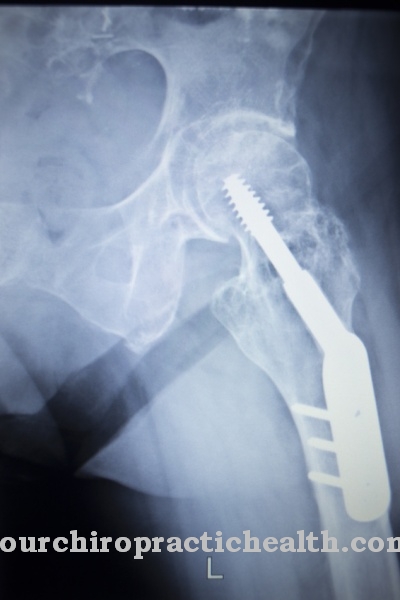The Positron emission tomography represents a nuclear medicine diagnostic method for the evaluation of metabolic processes within the human organism. The method is mainly used in oncology, cardiology and neurology.
What is positron emission tomography?

The Positron Emission Tomography (PET) is an imaging diagnostic method used in nuclear medicine that can be used to visualize metabolic processes in the human organism.
For this purpose, with the help of radioactively marked biomolecules (radiotracers or radiopharmaceuticals) and a special camera, cross-sectional images are produced, which serve to assess specific issues. The method is used in particular in oncology, cardiology and neurology.
Since positron emission tomography functionally maps the metabolic processes of the organism, it is in many cases combined with computed tomography (PET / CT), which provides additional morphological or anatomical information.
Function, effect & goals
The Positron emission tomography is used in particular for the diagnosis and early detection of tumor diseases such as prostate cancer, thyroid and bronchial carcinomas, meningiomas and pancreatic tumors.
In addition, the procedure is used to check the success of cancer therapy and to determine possible metastases (daughter tumors). Within neurology, positron emission tomography can be used to diagnose various impairments of the brain (including Parkinson's disease, Huntington's disease, low-grade gliomas, determining the triggering focus in epilepsy) and differentiate them from other diseases using differential diagnosis.
In addition, positron emission tomography enables an assessment of dementia-related degeneration processes. Via the visualization of the myocardial blood flow and the oxygen consumption of the heart muscle, the heart function can be checked within the cardiology department and, for example, coronary blood flow disorders or heart valve defects can be determined. For this purpose, depending on the target organ, a specific radiotracer (for example radioactively marked grape sugar if a tumor is suspected) is injected intravenously into the arm of the person concerned.
After about an hour (50 to 75 minutes) this has spread through the bloodstream in the target cells, so that the actual measurement can take place. When the radiotracer decays, positrons (positively charged particles) are released, which are unstable and release energy during their decay, which is recorded by detectors arranged in a ring. This information is transmitted to a computer which processes the data received into an accurate picture.
Depending on the metabolism of the specific cells, the radioactively labeled biomolecules are absorbed to different degrees. The cell areas that show an increased metabolism and correspondingly increased absorption of the radiotracer (including tumor cells) stand out in the computer-generated image through an increased glow from the surrounding tissue areas, which enables a detailed assessment of the extent, stage, localization and extent of the specifically present Disease is made possible. During the examination, the person concerned lies as quietly as possible on a couch in order to increase the informative value of the examination result.
Since muscle activity can also lead to an increased absorption of the radiotracer, especially glucose, a sedative can be used to avoid stress or tension. Following the positron emission tomography, a diuretic is administered intravenously to ensure that the radiotracer is eliminated promptly. In addition, the organism should be supplied with sufficient fluids. As a rule, positron emission tomography is combined with computed tomography, which enables a more precise and detailed assessment and reduces the duration of the examination.
Risks, side effects & dangers
Although it is assumed that the radiation exposure from the radioactively marked tracer is low (comparable to the radiation exposure in a computer tomography) and the radioactive particles are excreted promptly, a potential health risk cannot be completely ruled out. Accordingly, a Positron emission tomography an individual risk-benefit assessment always takes place.
In pregnant women, positron emission tomography is contraindicated due to the radiation exposure to which the unborn child is usually sensitive. An allergic reaction to the radiopharmaceuticals used can rarely be observed, which can manifest itself in the form of nausea, vomiting, skin rash, itching and shortness of breath. In very rare cases, circulatory problems can also be found. There may also be a bruise in the area of the injection needle's puncture site.
Infection, bleeding or injury to the nerves are very rarely caused by the injection. The use of a diuretic substance following positron emission tomography can cause a drop in blood pressure and, if the urine flow is impaired, colic (spastic contractions).
If an antispasmodic drug is used, glaucoma may worsen temporarily, and dry mouth and urination problems may occur. Glucose or insulin applied prior to positron emission tomography can cause temporary hypoglycaemia or hypoglycaemia in diabetics.













.jpg)

.jpg)
.jpg)











.jpg)